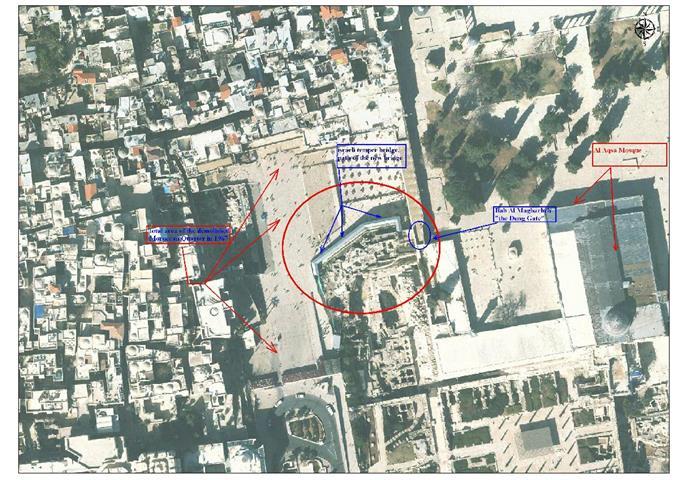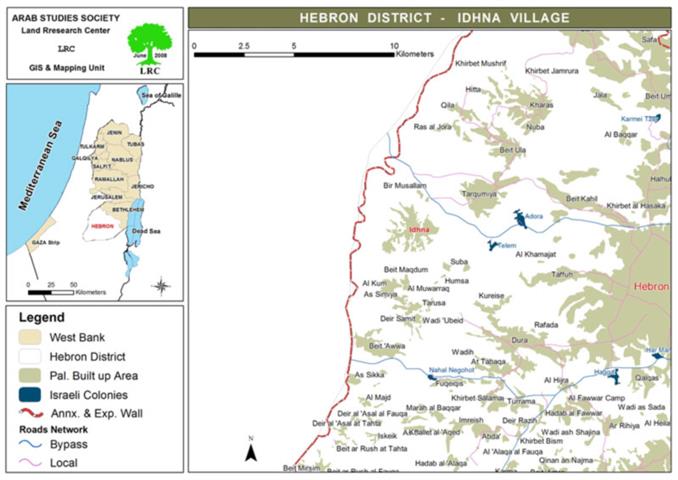On May 23, 2011, the Israeli Municipality of Jerusalem started with advanced steps to demolish the upper bridge that connect Bab Al Magharba, the gate that leads to Al Aqsa Mosque. This comes after the demolition of the historical hill that is located in Bab Al Magharba. In relation to the Bridge issue, Engineer Shlomo Ashkol of the Israeli municipality of Jerusalem claimed: ‘The Municipality will complete all legal procedures to demolish the upper temporary bridge near by Al Magharba Gate in the Old City of Jerusalem, in the event that the “Western Wall Heritage Fund” did not demolish it, since it is unsafe for the visiting public to the area‘. He also added that the bridge is no longer eligible to meet the Security and services civilian needs, hence it must be demolished and replaced with more appropriate substitute.
The current bridge targeted for demolishing; was originally built after the ruin of the historical hill in February 2007, when the hill first collapsed in 2004 due to the Israeli excavations under Al Aqsa Mosque and other parts of the Old city. This bridge was established for Security purposes to allow the Israeli security personal quick access to Al Aqsa Mosque squares, and to allow Jewish groups free and easy access to the area of what the Israeli call the “wailing Wall” originally Al Magharba neighborhood.
The decision to demolish the bridge can not be carried out until the Israeli Prime minister Benjamin Netanyahu approve it, who was also the Prime Minister in 1996 when he gave the order to open the tunnel under Al Aqsa mosque, which resulted at the time to confrontations between the Palestinian Jerusalemites and the Israeli police that ended with the death of 100 Palestinians.
The Islamic Religious Trust (Waqf office) shows that the path where the bridge is laid over, is one of the main entrances to Al Aqsa Mosque, and considered an Islamic Original Heritage, and the path used by Salah Al Din Al Ayubi to enter Jerusalem.
The Israelis on the other side, claim that the bridge is considered a main part of the Western Wall of the Temple, and the bridge is strategic for Security needs, since it lead directly to Al Aqsa Mosque square, and it is the fastest way for the Israeli Occupation Police to go through in case of any future clashes.
For such reasons and claims, the construction and the bridge and the entire Israeli excavations in that area is that main reason to any international, diplomatic and political crisis related to Jerusalem, as the Israeli activities in and around Jerusalem and Al Aqsa mosque in particular is viewed by the Palestinians and the Arab world as pure Israeli attempt to re-characterize the traditional outfit of Jerusalem and to Judaize the city in accordance to the claimed Jewish history there.
In 1996, Netanyahu, then the prime minister of Israel approved the decision to excavate the tunnel under Al Aqsa mosque and gave the orders to get it into effect, however, Uri Loplyanski the former Mayor of the Israeli Municipality of Jerusalem, did not allow this order to get further in application, in order to avoid the political crisis that Israel might face in general, and avoid disorder in Jerusalem.
The current Mayor of the Israeli Municipality of Jerusalem (Nir Barakat) has a different view on the issue. Shalom Yurashalmi, from the Israeli newspaper Maarive quoted Nir Barakat’s statement on the bridge issue in his article ‘the Bridge to Hell’ published on March 12, 2011, where Barakat stated: ‘The Building License that was issued for the new bridge comes in accordance with the original location of the Historical Hill, which makes the temporary built bridge is illegal since it is unnecessary to have two bridges‘. In other words, each day the bridge of Bab Al Magharba keep standing, it does so as an illegal structure, hence, prepare for its demolition and for possible wide scale protest along .
The bridge that is going to be demolished, and replaced with a new one is going to be located in the area the Israelis claim to be the Western Wall of Temple mount, which stands on the demolished Palestinian neighborhood the ‘Moroccan Quarter’ in 1967. This quarter was largely demolished in 1967 by the Israeli government in order to make public access to the Western Wall easier. Today, most of the area has been fully absorbed into the Jewish Quarter and almost no trace of it is left. This quarter was an 800-year old neighborhood located at the southeast corner of the Old City of Jerusalem. Map 01, it shows the location of the Israeli bridge, and it shows Al Aqsa mosque, and the demolished quarter in 1967.
MAP 01
As for Image 01, and Image 02 it shows the Israeli bridge, and the path that it goes through, beside the excavations held in the area, which forms a threat of collapse on Al Aqsa mosque.
IMAGE 01 IMAGE 02
The Forth Geneva Convention of 1949 mentioned within its articles, the right of preserving and protecting private, personal, group, and state properties and heritage, yet the Israeli governments are in different to all these conventions and articles. Some of the International Law articles that are violated:
-
Geneva’s Forth Convention 1949, Regulations respecting the laws and customs of war on land, Section III, Article 46: ‘Family honor and rights, the lives of persons, and private property, as well as religious convictions and practice, must be respected’.
-
Geneva’s Forth Convention 1949, Regulations respecting the laws and customs of war on land, Section III – Military authority over the territory of the hostile state Article 56: ‘The property of municipalities that of institutions dedicated to religion, charity and education, the arts and sciences, even when State property, shall be treated as private property. All seizure of, destruction or willful damage done to institutions of this character, historic monuments, works of art and science, is forbidden, and should be made the subject of legal proceedings’.
-
Geneva’s Forth Convention 1949, Part III, Status and treatment of protected persons, Section III – Occupied territories, Article 53: ‘Any destruction by the Occupying Power of real or personal property belonging individually or collectively to private persons, or to the State, or to other public authorities, or to social or cooperative organizations, is prohibited, except where such destruction is rendered absolutely necessary by military operations’.
















